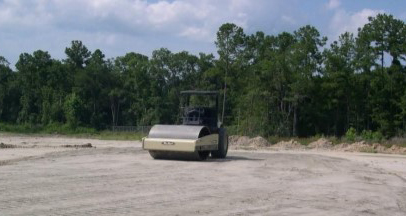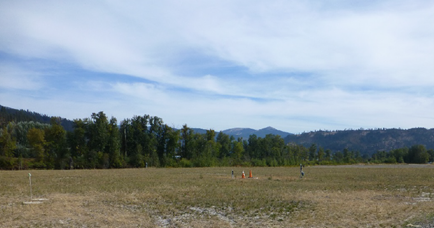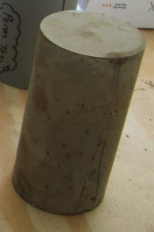Solidification/Stabilization
Overview
Solidification and stabilization are treatment technologies that achieve remediation goals by mixing contaminated materials with reagents that reduce leaching1, and thus mobility, of the contaminants. Rain, stormwater runoff, and groundwater flow can leach contaminants from soil, sludge, and other wastes in the environment and transport them to groundwater or nearby surface water bodies, increasing potential exposure pathways for human and ecological receptors. Although these two treatment technologies rely on different mechanisms to immobilize contaminants, solidification and stabilization (S/S) are frequently implemented together and discussed as a single technology.
Mechanisms for Immobilizing Contaminants
In solidification, the reagents encapsulate the contaminated medium in a solid material that is impermeable to water. As a result, the surface area of the contaminated medium exposed to leaching is decreased (EPA, 2000). The solidified material can range in appearance from granular to a monolithic block of material (Figure 1).
In stabilization, the reagents cause a chemical reaction that reduces the leachability of contaminants (EPA, 2020). The reaction either chemically immobilizes contaminants or reduces their solubility by forming, for example, insoluble metal hydroxides, carbonates, or silicates. The process most often does not alter the physical nature of the treated waste.
The reagents employed to reduce leaching are referred to here as "binders." The most common binders are Portland cement and pozzolans2. Other reagents, referred to as "additives," target specific contaminants to reduce their leachability or improve specific properties of the treated material (for example, to accelerate the cure/set time of the mixture).

Figure 2: Roller compacting SS material treated ex situ that was used as backfill (Adapted from Bates and Hills, 2015).
S/S can be applied in situ3 or ex situ4 to a variety of solid and liquid wastes. S/S is one of the most frequently selected technologies to treat contaminants in situ at Superfund sites. It is most commonly applied to treat soil, but is occasionally used to treat groundwater (EPA, 2020![]() ). To further limit infiltration of water, containment technologies, such as an engineered cap or slurry walls, may be constructed around in situ-treated material. Ex situ-treated material might be repurposed onsite, for example, as backfill for the excavation (Figure 2), or transported offsite to a landfill for disposal.
). To further limit infiltration of water, containment technologies, such as an engineered cap or slurry walls, may be constructed around in situ-treated material. Ex situ-treated material might be repurposed onsite, for example, as backfill for the excavation (Figure 2), or transported offsite to a landfill for disposal.
S/S offers several advantages compared to other remediation technologies, as well as limitations that may figure into the evaluation of S/S for a remedy (Table 1).
Table 1. Some of the Advantages and Limitations to Using S/S Treatment1
| Advantages |
| Can treat complex mixtures of different wastes, including some types of organic chemicals and NAPLs (e.g., coal tar). |
| Can be implemented in situ or ex situ. |
| Can be implemented in dry or wet conditions, which reduces dewatering and waste management issues. |
| Uses simple, readily available equipment and materials. |
| Most binders are relatively inexpensive. |
| Can be implemented using widely available construction equipment and does not require specialized skills. |
| In the absence of volatile contaminants, no secondary byproducts are generated. |
| Onsite management of in situ S/S product conserves landfill space and transportation costs. |
| Can improve compressive strength of the contaminated media to facilitate beneficial reuse of land. |
| Can reach a fixed treatment endpoint relatively quickly. |
| Limitations |
| Does not typically destroy contaminants or decrease contaminant toxicity. The technology controls contaminant migration, which requires long-term stewardship. |
| Depth of contamination can limit application based on the reach of excavation and mixing equipment. |
| Large rocks or cobbles, debris, and other underground obstructions must be removed prior to treatment. |
| Subsurface heterogeneity can affect in situ mixing and treatment, which can result in uneven performance. |
| Due to the heat generated during mixing with reactive chemicals, volatile organic compounds may be emitted, requiring pretreatment or vapor collection and treatment. |
| May increase the volume of the treated waste requiring disposal or in-place management. |
| Leaving S/S product in an area subject to seismic activity, weathering, freeze-thaw cycles, or other physical disturbances can compromise its integrity and increase the potential for leaching of contaminants. |
| Predicting long-term behavior and protectiveness can be challenging. |
| Can alter the physical setting (e.g., creating a mound or changing groundwater flow direction). |
| Options for post-treatment modifications may be limited due to the physical changes of the contaminated media. |
| May inhibit future, more comprehensive restoration of sensitive areas. |
1 Adapted from AEPI, 1998; ITRC, 2011; and Government of Canada, 2017.

Figure 3: Soil in a 1.5-acre area at the St. Maries Creosote site in Idaho was stabilized with Portland cement and pozzolans, then revegetated. (For more information, see the case study in Examples of Site-Specific Use.)
The feasibility of S/S, like other treatment technologies, is site-specific depending on the chemicals of concern, extent of the contamination, geology/hydrogeology, site accessibility, remedial action objectives, etc. These factors are discussed further in the Application section. The Examples of Site-Specific Use section features a case study on the selection of S/S to treat creosote-contamination at the St. Maries Creosote site (Figure 3) in Idaho, as well as links to resources on other site-specific applications that may provide insight on the types of sites where S/S has been applied.
References:
Army Environmental Policy Institute (AEPI). 1998. ![]() Solidification Technologies for Restoration of Sites Contaminated with Hazardous Wastes.
Solidification Technologies for Restoration of Sites Contaminated with Hazardous Wastes.
Bates, E. and C. Hills. 2015. ![]() Stabilization and Solidification of Contaminated Soil and Waste: A Manual of Practice. Hygge Media.
Stabilization and Solidification of Contaminated Soil and Waste: A Manual of Practice. Hygge Media.
EPA, 2020. ![]() Superfund Remedy Report, 16th Edition. EPA-542-R-20-001. July.
Superfund Remedy Report, 16th Edition. EPA-542-R-20-001. July.
EPA. 2000. ![]() Solidification/Stabilization Use at Superfund Sites. EPA 542-R-00-010.
Solidification/Stabilization Use at Superfund Sites. EPA 542-R-00-010.
Government of Canada, 2017. Factsheet: Solidification/Stabilization—In Situ. —Ex Situ.
ITRC (Interstate Technology & Regulatory Council), 2011. Development of Performance Specifications for Solidification/Stabilization.
Helpful Definitions
Leaching is the transfer of a contaminant from a solid or semi-solid material into water that contacts it. ↩
Leaching is the transfer of a contaminant from a solid or semi-solid material into water that contacts it. ↩
Pozzolans are silica- or alumina-rich materials (commonly process wastes, such as fly ash and cement kiln dust) that can react with calcium hydroxide to form compounds with cementitious properties. ↩
Pozzolans are silica- or alumina-rich materials (commonly process wastes, such as fly ash and cement kiln dust) that can react with calcium hydroxide to form compounds with cementitious properties. ↩
In situ treatment occurs in place, without removing the contaminated material. ↩
In situ treatment occurs in place, without removing the contaminated material. ↩
Ex situ treatment involves removing the contaminated material, e.g., by excavation or pumping, and transporting it to another location for treatment. ↩
Ex situ treatment involves removing the contaminated material, e.g., by excavation or pumping, and transporting it to another location for treatment. ↩


